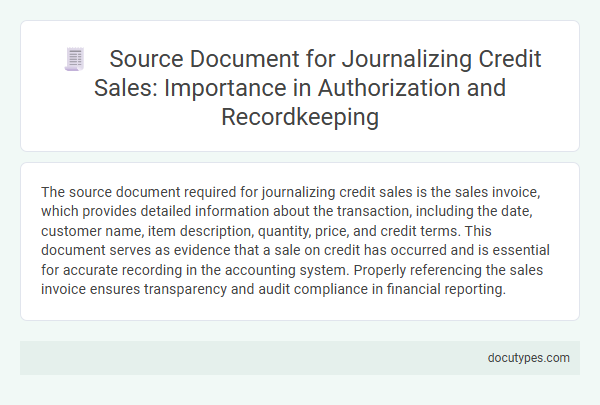The source document required for journalizing credit sales is the sales invoice, which provides detailed information about the transaction, including the date, customer name, item description, quantity, price, and credit terms. This document serves as evidence that a sale on credit has occurred and is essential for accurate recording in the accounting system. Properly referencing the sales invoice ensures transparency and audit compliance in financial reporting.
Introduction to Source Documents in Credit Sales
Source documents provide essential evidence for transactions in accounting, especially credit sales. Understanding the correct source document is crucial for accurate journalizing and maintaining financial integrity.
- Source Document Definition - A source document is the original record that captures the details of a financial transaction.
- Role in Credit Sales - In credit sales, the source document validates the sale and serves as proof of the amount owed by the customer.
- Common Document Used - The sales invoice is the primary source document required for journalizing credit sales in your bookkeeping process.
Definition and Types of Source Documents
The source document required for journalizing credit sales is typically a sales invoice. A sales invoice serves as the primary evidence of the transaction, detailing the items sold, credit terms, and customer information. Different types of source documents include sales orders, delivery receipts, and credit memos, each supporting various stages of the credit sales process.
Role of Source Documents in Journalizing Credit Sales
The source document required for journalizing credit sales is the sales invoice. This document provides essential details such as the date of the sale, customer information, goods or services sold, and the amount owed.
Source documents play a critical role in ensuring accurate and verifiable accounting records. They serve as evidence of the transaction and support the entries made in the sales journal for credit sales.
Importance of Authorization in Credit Transactions
Authorization plays a crucial role in credit transactions by ensuring accuracy and preventing fraud. The source document required for journalizing credit sales provides verified evidence of the transaction's legitimacy.
- Source Document Identification - Invoice or sales slip serves as the primary record for journalizing credit sales, capturing essential transaction details.
- Verification of Transaction - Authorization confirms that the credit sale has been approved, supporting accurate financial reporting.
- Internal Control - Proper authorization of credit sales strengthens internal controls, reducing the risk of unauthorized or erroneous entries.
Source Documents as Proof of Authorization
The source document required for journalizing credit sales serves as official proof of authorization for the transaction. This document ensures that all credit sales entries are valid and properly recorded in your accounting system.
- Sales Invoice - The primary source document that authorizes and details the credit sale, including customer information, items sold, and amounts.
- Customer Purchase Order - Acts as a preliminary authorization from the buyer, confirming the intent to purchase on credit.
- Delivery Receipt - Supports authorization by confirming goods or services have been delivered to the customer.
Maintaining these source documents is essential for accurate and authorized journalizing of credit sales transactions.
Enhancing Recordkeeping Accuracy with Source Documents
What is the source document required for journalizing credit sales? The primary source document for recording credit sales is the sales invoice. Using the sales invoice enhances recordkeeping accuracy by providing detailed information about the transaction, such as customer details, sale amount, and terms of credit.
Internal Controls Supported by Source Documents
The source document required for journalizing credit sales is typically the sales invoice. This document serves as primary evidence of the transaction, detailing the customer, date, amount, and terms of the sale. Effective internal controls rely on these source documents to ensure accuracy, prevent fraud, and support audit trails in financial reporting.
Audit Trails and Legal Compliance in Credit Sales
The source document required for journalizing credit sales is typically the sales invoice. This document provides a detailed record of the transaction, including buyer information, items sold, prices, and payment terms.
Maintaining accurate sales invoices supports a clear audit trail, ensuring transparency in financial reporting. Your adherence to these records is crucial for legal compliance and effective internal controls in credit sales management.
Common Challenges in Document Management
| Topic | Details |
|---|---|
| Source Document for Journalizing Credit Sales | Sales invoice is the primary source document required for recording credit sales in the accounting journal. It provides detailed information about the transaction, including customer details, products or services sold, quantities, prices, and terms of credit. |
| Common Challenges in Document Management | Managing source documents for credit sales involves challenges such as timely collection of sales invoices, ensuring accuracy and completeness of data, preventing document loss or damage, and maintaining organized filing systems. Inefficient document management can lead to errors in authorization, misstatements in financial records, and delays in revenue recognition. You must implement robust controls and use digital tools to enhance document traceability and integrity. |
What Is the Source Document Required for Journalizing Credit Sales? Infographic

